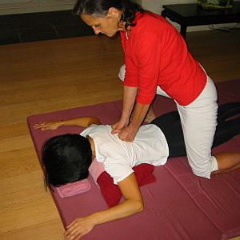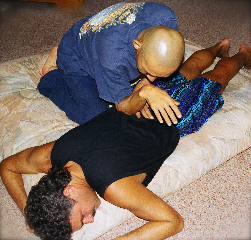
Kathy Kapps Practicing Zen Shiatsu
For years this has been the most common question people ask me. Honestly, I believe my answer is controversial . . .
Acupressure uses the same points as Acupuncture, but works with the hands instead of needles. Thus, any method that stimulates Acupressure points without needles can be considered a style of Acupressure.
Shiatsu techniques stimulate the Acupressure points directly and very powerfully for healing purposes, thus it’s a major form of Acupressure. I know many Shiatsu teachers would state this differently, keeping Shiatsu in its own unique category.
Shiatsu Therapy has many applications, such as Sports Medicine, Pain Management, and Spa Work. The different forms of Shiatsu depend upon the way the Acupressure points are stimulated: 1) through the rhythm of the practitioner, and 2) through the Shiatsu bodywork method – using the hands, knuckles, knees, elbows, feet, full-body movements, and gentle stretching. In fact, many of my Acupressure Routines include Shiatsu techniques.
To learn more about how to practice Shiatsu Therapy, I have two resources for you. First, here’s my video, Zen Shiatsu — Traditional Asian Bodywork Therapy. In it, I demonstrate how to give a complete Shiatsu treatment. The video is available as a rental, a download, and a DVD.
Next, here’s my Shiatsu Instruction booklet. This fully illustrated booklet shows 50 traditional Zen Shiatsu techniques.
Shiatsu, as a healing art, has profound cultural Japanese roots. The Namikoshi family, beginning in the early 1900s, developed Shiatsu Therapy in Japan, separating it from traditional Japanese Amma Massage. Namikoshi was the first to provide a physiological understanding of Shiatsu Therapy’s benefits.

Michael Reed Gach receiving Zen Shiatsu from his teacher Reuho Yamada
Since the establishment of Namikoshi Shiatsu in Japan, which uses primarily the thumbs, many other styles of Shiatsu have developed, incorporating numerous creative ways of pressing and stretching the body.
Shiatsu is one of the most well-known forms of Acupressure in the United States. This was the result of several Shiatsu books by Japan Publications, which were distributed here by Harper and Row, bringing these teachings mainstream in the 1960s, 70s, and 80s.
Shiatsu Therapy has continued to grow throughout the world in scope, application, technique, and training, and is a recognized healing practice.
